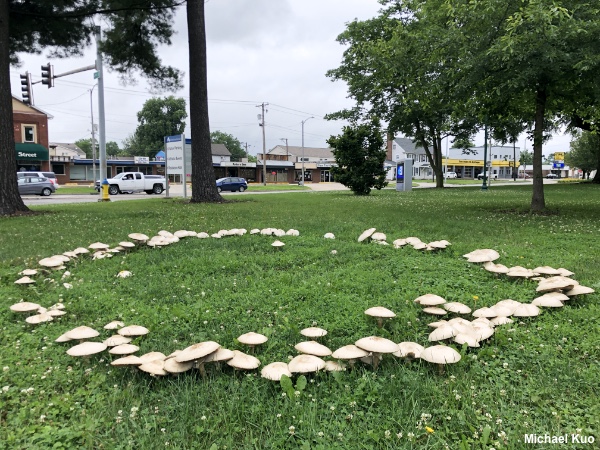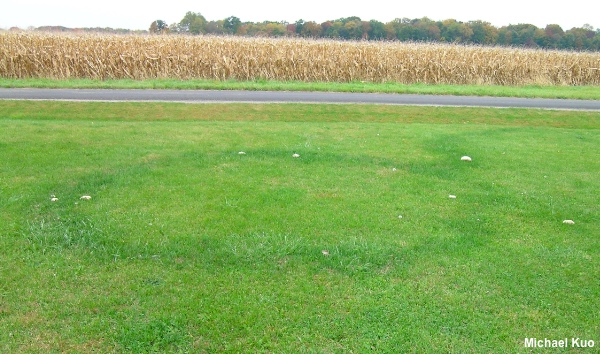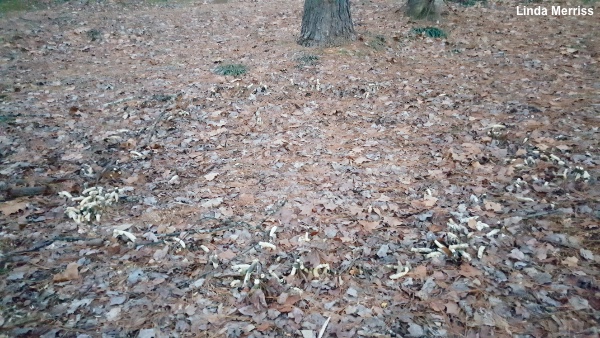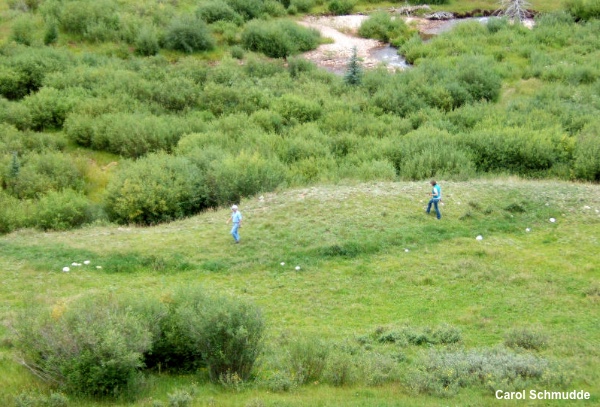
|
Fairy Rings by Michael Kuo Understanding mushroom "fairy rings" requires an understanding of how mushrooms grow. Like apples on an apple tree, the mushrooms we see are only the reproductive fruiting bodies of the "true" organism, which is called a mycelium. The mycelium grows underground; it is a mass of elongated, hungry cells that feed on nutrients, pushing and growing through the substrate as long as there is food available. When the substrate is evenly composed—that is, when the food supply is constant and uninterrupted—the mycelium grows ever-outward, leaving behind the nutrient-poor substrate it has consumed and pushing into new territory. If the mycelium decides to produce mushrooms, the result is a fairy ring. Many species produce mushrooms more or less annually.
What triggers mushroom production is rather up for debate. Studies indicate that many fungi—the morels, for example—produce mushrooms when they face nutrient deprivation, sort of as a survival strategy: "I'm done for, so I'll make a mushroom that is covered with spores, lift it up above the ground, and let the wind take my babies to a new home." This explanation doesn't seem to fit the mushrooms that make fairy rings, however, since they have not run out of food. Regardless of what prompts the mushrooms, the phenomenon of the ever-widening ring of mycelial activity is frequently observed, and can even be seen without the mushrooms themselves; the grass is typically darker where the mycelium is active.
Just about any terrestrial mushroom can pop up in fairy rings. What is required is simply an evenly composed substrate. Since lawns are tended environments created by people whose goal is an evenly composed substrate, they are frequent fairy ring sites for grass-loving mushrooms like Marasmius oreades, Chlorophyllum molybdites, and several species of Agaricus. Woods are messier than lawns, and involve territory that is usually not very consistent in its composition--but every so often one finds a ring or partial ring created by a woodland species in a rare patch of stable environment; I have seen species of Amanita and Russula, for example, fruiting in large arcs in the woods.
Each year, a typical fairy ring expands its radius. Some studies have assumed even growth rates and calculated that the subject mycelium must be hundreds of years old! A Norwegian study (Abesha et al., 2003) of Marasmius oreades fairy rings in coastal grasslands is attempting to determine whether new rings are cloned from old rings, or whether they result from spores falling in new locations and germinating new mycelia.
A final note: Marasmius oreades is often called "The Fairy Ring Mushroom" in field guides, since its most frequent growth pattern is in rings. But it is not the only fairy ring mushroom; this is a case where the "common name" for a mushroom can get in the way of successful identification! Cite this page as: Kuo, M. (2020, January). Fairy rings. Retrieved from the MushroomExpert.Com Web site: http://www.mushroomexpert.com/fairy_rings.html © MushroomExpert.Com |



